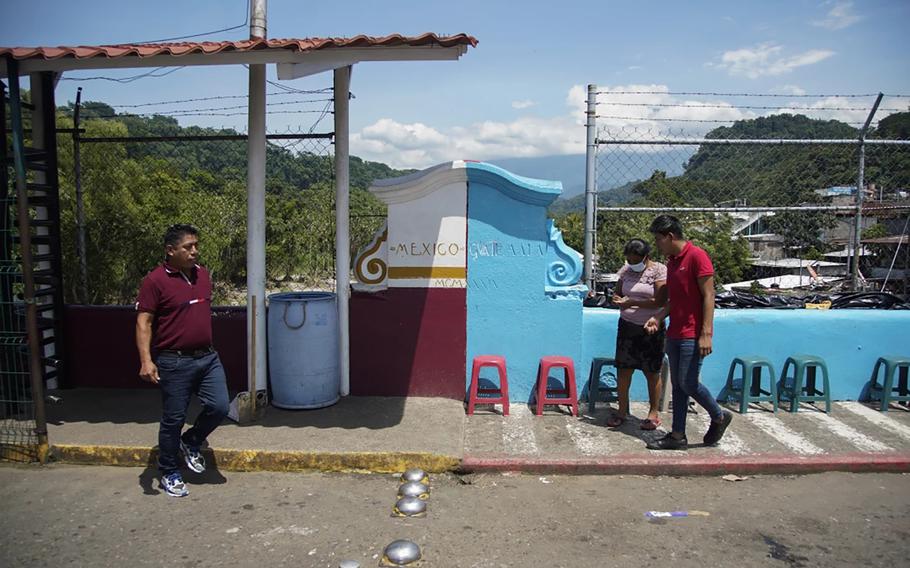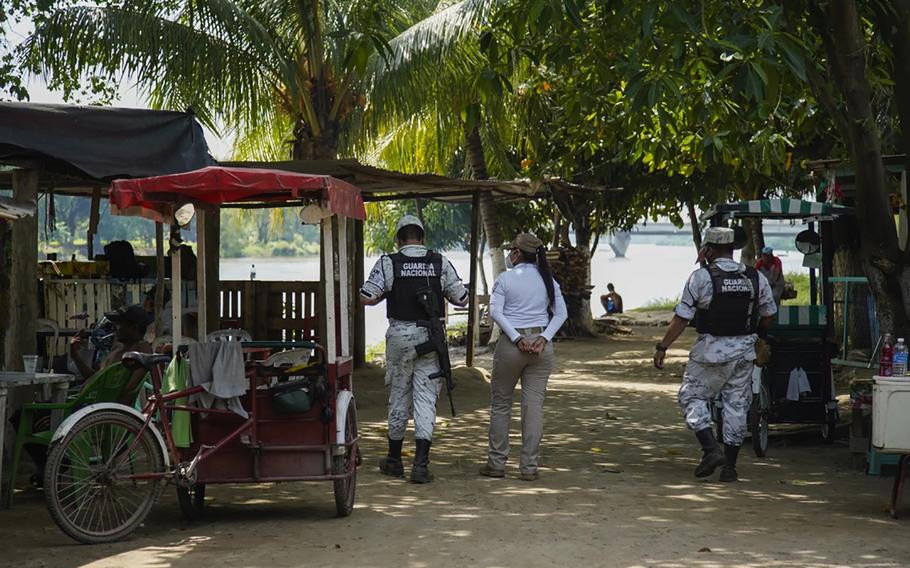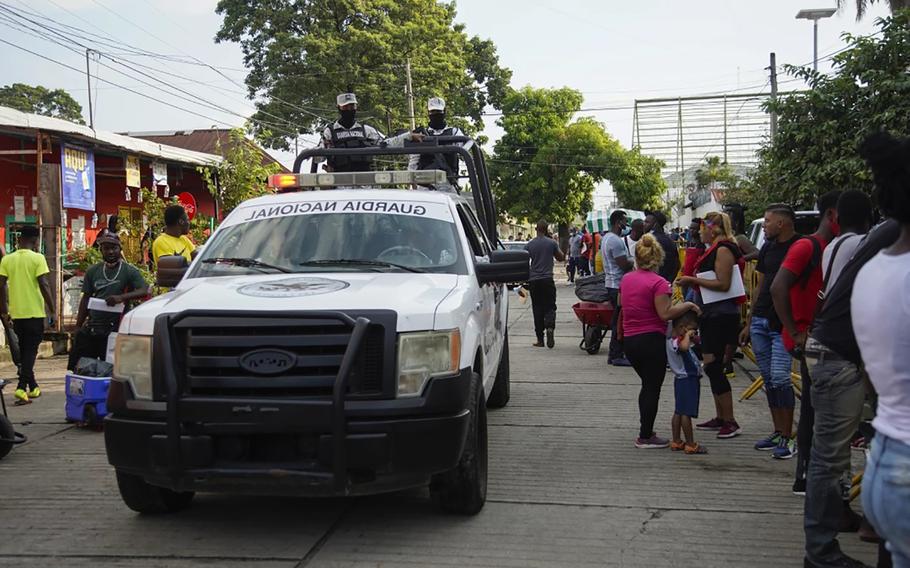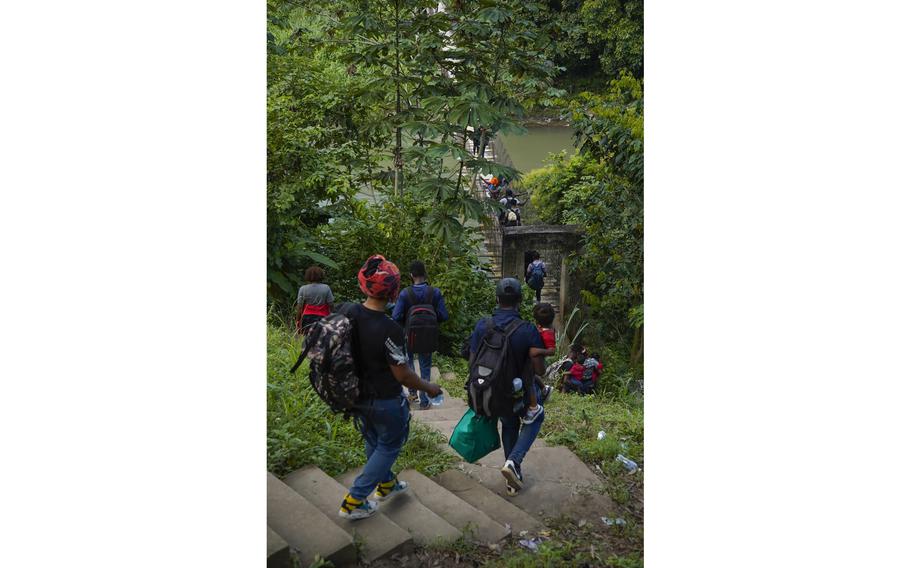
Pedestrians cross between Mexico and Guatemala at the port of entry that connects El Carmen in the San Marcos department of Guatemala with Talisman in Chiapas, Mexico. (Alejandro Tamayo, San Diego Union-Tribune/TNS)
TAPACHULA, Mexico (Tribune News Service) — At towns along the busiest stretch of Mexico’s southern border, there are official crossings over bridges at the ports of entry. Then there are the unofficial crossings, used often by locals to pass back and forth in their daily routines.
In Talismán, that crossing is a zipline that runs underneath the port of entry that costs roughly the same as a San Diego trolley ride. Throughout the day, families and friends whiz north across the river that separates the two countries in order to shop, eat and drink. Men with cargo strapped to their backs and foreheads hitch their goods to the zipline and hang from their packs as they slide across.
In Ciudad Hidalgo, it’s inner tubes with pallets tied to the top that are pushed across the river with long poles. Bicycle taxis wait on the Guatemala side to greet tourists while workers load and unload crates of goods from beer to shampoo that crossed on the makeshift rafts.
Amid all of this cross-border commerce, Mexican immigration officials look the other way — until asylum-seekers try to pass through. Small groups of officials from Instituto Nacional de Migración, or INM, and the Mexican National Guard approach those they believe are trying to migrate north and ask for travel documents. Those without them are detained.
“This has been a crossroads for people for who knows how long, and there’s a lot of culture built up around that,” said Andrew Bahena, who monitors human rights conditions in the area for Los Angeles-based Coalition for Humane Immigrant Rights, or CHIRLA. “Who is not able to cross on those rafts openly? Migrants and people that are seeking protection. The incongruency is very clear.”
The distinction in treatment between cross-border commerce and people trying to seek refuge is much like that of the San Diego-Tijuana border, which recently reopened to vaccinated tourists after being closed for much of the pandemic. Asylum-seekers are still not able to request protection at U.S. ports of entry even if they are vaccinated.
The immigration enforcement tactics used at the two borders are also similar. At its southern border, Mexico has incorporated strategies used by its northern neighbor at the border they share, partly in response to pressure from the United States to keep migrants from reaching its soil.
Pedro Rios, director of the American Friends Service Committee’s U.S.-Mexico Border Program, said many advocates refer to these similarities as an exportation of U.S. border policies.
While the migration agreements between the two countries are not clear, human rights observers see their effects in what they call the increased militarization of Mexico’s southern border — a phrase often used by human rights observers at the U.S.-Mexico border to describe the United States’ efforts to keep migrants out.
Though Mexico doesn’t catch nearly everyone crossing its southern border, its enforcement raids and checkpoints and the consequences of them are enough to keep migrants fearful.
That fear has held tens of thousands captive in the nearby city of Tapachula, stalled by a dysfunctional asylum system that they believed was their only option to travel out of the region safely. And for those who do get caught, they often end up detained in the largest immigration detention center in Mexico, which is so crowded that some are forced to sleep in the outdoor recreation area on mats.
When the United States began expelling migrants of various nationalities to Mexico during the COVID-19 pandemic, Mexico copied the strategy, using ambiguous legal processes to send migrants from many countries across the border to small Guatemalan towns without the resources to help them.
As at the U.S.-Mexico border, that fear of enforcement and its consequences also means migrants end up in increasingly dangerous situations to try to get through undetected.

Mexican National Guard and an immigration official patrol the border near the river at Paso del Coyote in Cuidad Hidalgo, Chiapas. (Alejandro Tamayo, San Diego Union-Tribune/TNS)
‘So much suffering’
On a recent October morning, 10 taxis clustered in a clearing down a dusty, country road in the jungle near the small town of Guadalupe Victoria between Ciudad Hidalgo and Tapachula. They had been commissioned by smugglers and were waiting to pick up migrants.
Suddenly the taxis took off, empty, back toward the highway to Tapachula. They barely escaped an approaching squad of Mexican immigration officials and National Guard.
The officials soon found and detained three Haitian migrants on a nearby path through the jungle.
“So much suffering,” a Haitian woman said in Spanish as officials walked her back to their van. “I didn’t imagine this.”
The officials returned to the trail, looking for signs of other migrants. They reached a rickety pedestrian bridge made of old wooden slats, some with enough room in between for a person to fall to the river more than 30 feet below. The National Guard soldier watched, his long gun hanging in front of him, as the immigration officials checked in the brush before deciding to leave with the three they already had in custody.
After a lookout on a motorcycle saw them leave, smugglers quickly began moving roughly 50 more Haitians across the bridge. One smuggler held a machete. Another had a gun.
The migrants’ hands gripped the sides of the bridge as they carefully stepped from board to board, many wearing the flimsy sandals that had carried them across as many as nine countries. After passing through places like the Darién Gap — a harrowing stretch of jungle separating Colombia and Panama where many migrants lose their lives or loved ones — they knew that this bridge was just another obstacle on their journey.
Once across, they walked quickly to their next hiding place, hoping that the immigration officials and National Guard wouldn’t come back.

Mexican National Guard patrol the street outside one of the asylum offices in Tapachula. (Alejandro Tamayo, San Diego Union-Tribune/TNS)
Militarized borders
Mexico deployed its National Guard to its southern border in 2019 after former President Donald Trump threatened tariffs if Mexico didn’t stop migrants from coming north. Trump had deployed the U.S. National Guard to the U.S.-Mexico border the year prior, becoming one of several U.S. presidents to do so.
This militarization of the borders has drawn condemnation from human rights observers in both countries.
“Each time there is a stronger presence of military bodies,” said Yuriria Salvador, a human rights worker with the Centro de Derechos Humanos Fray Matías de Córdova A.C. in Tapachula, “that affects us all.”
San Diego-based Rios said that border militarization is a process that happens over time to normalize the presence of troops in the community.
“It’s this belief — a false belief — that to contend with migrants and with immigration, it has to be framed under a context of war, that only with a military response could we effectively deal with immigration,” Rios said.
National Guard and other military forces have a history of human rights violations, Salvador said. Now Mexico has National Guard troops at both of its land borders.
Ruben, a 24-year-old who fled his home country of Haiti in 2016, and who is not being fully identified because he is still in danger in southern Mexico, was traumatized by his experience with the Mexican National Guard in the north.
Ruben initially went to Chile after escaping Haiti, where he’d been kidnapped twice and his girlfriend and father had been killed. He faced racism and discrimination in Chile, so he headed for Miami, where he has family.
He, along with thousands of other Haitians, ended up in Ciudad Acuña, across the river from Del Rio, Texas, where U.S. Border Patrol officials on horseback were photographed chasing down Haitian men carrying food. He saw the conditions that fellow Haitians were experiencing once they reached U.S. soil and decided not to cross yet.
In the middle of the night, Mexican National Guard entered his hotel room while he was asleep and arrested him, he said. When he asked questions about what was happening to him, they pushed him, injuring his arm, he said.
A few weeks later, the marks were still visible in his skin.

A group of Haitian migrants following smugglers’ instructions cross the Cahoacan river. Many carry their young children across the rickety bridge in addition to their belongings. (Alejandro Tamayo, San Diego Union-Tribune/TNS)
Checkpoints
At one of the major immigration checkpoints in Huehuetán, a little northwest of Tapachula, on a recent morning, a family of Haitians sat in a cell, waiting to be taken back south.
The National Guard soldier on duty said that they would have to get documents in Tapachula — meaning that they, like thousands of others, would have to request asylum from an office that is so backlogged with cases it closed to new ones for several months earlier this year.
The family was soon loaded into a prison van with the Gobernación logo emblazoned on the side — Mexico’s equivalent of the Department of the Interior. This section of Mexican government includes its immigration agency, which Mexican officials often call “Inami.” But migrants in Tapachula use the word “Gobernación” to refer to immigration officials because they see it everywhere where there is enforcement, from the detention center to the checkpoints.
In some ways, these checkpoints are similar to those run by U.S. Border Patrol in the San Diego area. Cones or other barriers reduce the number of traffic lanes as cars approach the officials.
But unlike Border Patrol agents, who will often ask drivers and passengers in private cars about their citizenship status, Mexican immigration officials generally limit their searches to the passengers of taxis and buses.
Officials in both countries use some measure of profiling in deciding whom to interrogate further.
INM officials look quickly at the faces of the passengers and ask for travel documents from those whom they believe are migrants.
INM did not respond to questions from the San Diego Union-Tribune about rules that agency might have on racial profiling or how it identifies whom to search.
U.S. Border Patrol has received pushback for certain cases of racial profiling — including two U.S. citizen women who sued after an agent in Montana detained them in 2018 because they were speaking Spanish while shopping. But the Supreme Court in a 1976 decision gave the agency broad authority to select cars for inspection at checkpoints without any articulable reason.
Rios said that he knows U.S. citizens whose primary language is Spanish and who do not present as White who have found themselves held up at checkpoints because of this.
Tapachula-based Salvador said the presence of military doing immigration enforcement work at these checkpoints is even more significant because of the history of resistance in the state of Chiapas, where the Zapatistas were based.
“Mexico cannot have a bad relationship with the United States. There is a pressure that is recognized and clearly has an effect of externalizing the borders,” Salvador said. “On the other hand, we can’t infantilize the governments of the region. It’s very convenient for authoritarian governments to use the discourse of migration as an excuse to augment military forces in the territory, to heighten control over resources and highways, etc.”
Flights south
The United States began expelling people, or removing them without following normal processing protocols including basic asylum screenings, in March 2020, shortly after the world shut down due to the COVID-19 pandemic. Under the rule, known as Title 42, people of various nationalities could be sent back to Mexico or to their home countries.
Expulsions are different from deportations. Deportation is an official act in which someone is sent back to a country where they have permission to live, generally their country of origin. Expulsions break those foreign policy norms. For example, Hondurans expelled from the United States to Mexico don’t have permission to be in Mexico either.
This summer, human rights observers documented Mexican officials similarly detaining migrants from various backgrounds in the Tapachula region, particularly Haitians, and pushing them back to Guatemala — even people who had been recognized as refugees by Mexico.
In August, the Biden administration expanded expulsions to include flights from Texas directly to Tapachula, and Mexican officials often then expelled the migrants from those flights to Guatemala. According to human rights observers, Mexico began conducting its own internal flights to expel people at its southern border after taking them into custody further north.
On an afternoon in late September, Anyela Zacarias of the government human rights office in the Guatemalan department of San Marcos, which lies on the border with Mexico, stood with colleagues on the bridge above the zipline that connects Talismán with El Carmen watching for migrants to interview about their experiences.
“They are expelled in an illegal way,” she said. Zacarias had even heard reports of migrants being expelled through the river on rafts, but she hadn’t been able to independently confirm those stories.
She was particularly troubled by what she’d heard from migrants who’d experienced chain expulsion — expelled first by the United States into Mexican immigration custody and then expelled again to Guatemala.
Many don’t get their belongings back from U.S. officials when they’re expelled, she said. Migrants expelled to Tijuana have told similar stories to the Union-Tribune.
Multiple explusions
Mexican officials had been sending migrants to the tiny town of El Carmen, according to observers and journalists. More recently, the buses have been heading to the other border crossing in the region that connects to the Guatemalan town of Tecún Umán.
Some buses stop on the bridge to Tecún Umán so that expelled migrants walk on their own into Guatemala. That removes some of the legal complications that Mexico would face in asking its southern neighbor to more officially receive people who are from elsewhere in the world.
Other buses filled with Guatemalans drive into the town to the Módulo de Atención al Migrante, or migrant service center, which greets returnees with towering walls topped with razor wire. When the gate opens, a health department tent is visible on one side of the courtyard.
Buses arrive throughout the afternoon, and as the men and women unload, workers from nearby money exchange shops surround them, stacks of cash and calculators in hand, with offers for quetzals.
It is unclear from their stories whether the Guatemalans are being expelled or officially deported from Mexico — but many described being expelled from the United States into Mexican immigration custody.
One young man told the Union-Tribune on an early afternoon in October that he was expelled from the United States twice. Then Mexican immigration officials sent him back to Guatemala from Ciudad Juárez by bus. The journey took four days.
From there, the young man had a six-hour walk to get home. He said he left in the first place because gangs prevented him from working, and living conditions were difficult.
A 25-year-old man who left his home to try to pay off his debt said he crossed to the U.S. from Ciudad Juárez as well and was likewise expelled to Mexico. Then Mexican police assaulted him and took his money, he said. He ended up caught by Mexican immigration officials and similarly sent to Tecún Umán on a bus.
He said he wasn’t allowed off the bus during the trip.
“It was awful being in Mexican immigration custody,” he said.
His shoe tongues flapped as he walked. He was still missing his laces from being in custody.
Siglo XXI
If migrants apprehended by Mexican officials aren’t expelled, they often end up at Siglo XXI, the detention center near the border.
Officially called a “migration station,” Siglo XXI is the largest immigration detention facility in Mexico. It has a capacity of 960 people according to the Global Detention Project, slightly less than that of San Diego’s Otay Mesa Detention Center, according to a U.S. government report.
From a nearby hillside, sleeping mats are visible in a shaded area of the detention center’s outdoor recreational space, suggesting that the facility has run out of beds. The hill is close enough that the men’s yells reach it occasionally.
The Union-Tribune observed one man bathing himself standing naked at a sink to one side of the yard. It is not clear whether the men in the yard had access to other means of washing themselves.
INM officials contacted through WhatsApp did not respond to questions from the Union-Tribune about the facility.
Salvador has conducted human rights visits there.
“People are sleeping on top of each other, even on the patio,” she said. “There are people facing long periods of detention without any reason. Entering Mexico in an irregular way is an administrative issue, not a crime. However, the treatment they’re giving to migrants and people requesting international protection is a punishment.”
She’s documented dismal conditions that include little to no access to basic services, as well as violence and mistreatment.
In June, a human rights monitoring collective that includes her organization published a report with allegations of torture at Siglo XXI.
One man who spoke to the Union-Tribune shortly after getting out of the facility also said he’d been tortured there.
When buses arrive there full of migrants in custody, they stop first on the south side of the building to let off women and families. They will spend a day or so in custody, despite a new Mexican law from November 2020 that says minors shouldn’t be held in immigration detention.
At the beginning of October, a toddler was visible in the window of the family side of the detention center, small hands gripping the bars on the windows.
INM did not respond to questions about its use of family detention.
The United States has family detention centers as well. In October, the average daily population in these facilities was well under their capacity, but they still held hundreds, according to data gathered by Syracuse University’s Transactional Records Access Clearinghouse.
Once the families are released in Tapachula, they have to come back to Siglo XXI every week to check in, according to several families waiting outside to do so.
“We tell them we don’t have money for taxis, but it doesn’t matter to them,” said Ulises, a father from El Salvador who had to budget to be able to make the weekly trips along with the 1,000 pesos, or roughly $48, his family paid each month to rent an outdoor patio to sleep on.
He fled with his wife and four children after a Salvadoran official threatened to kill his wife and the police did nothing, he said.
Once the families are off the buses, the drivers pull to the other side of the detention center, past a guard tower and through a gate. The men who file off will likely spend months in the crowded facility.
©2021 The San Diego Union-Tribune.
Visit sandiegouniontribune.com.
Distributed by Tribune Content Agency, LLC.